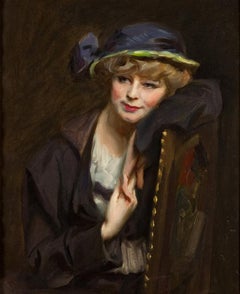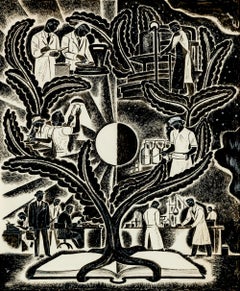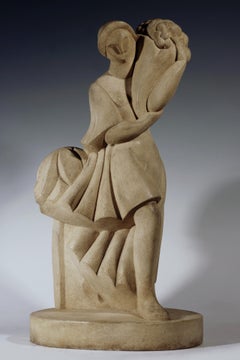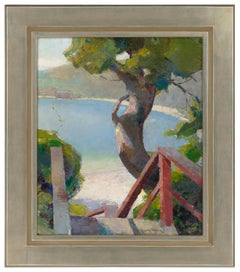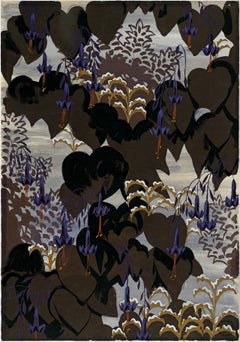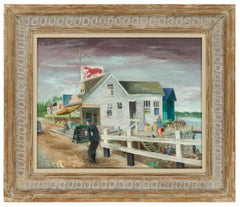Seidenberg Antiques Art
to
54
12
7
8
9
Overall Width
to
Overall Height
to
1
4
34
51
3
3
17
6
4
1
57
28
3
52
26
25
22
16
14
13
12
11
10
10
7
7
6
5
5
5
5
5
5
41
30
22
17
15
3
2
2
2
2
69
90
Oil on Canvas Portrait Painting of a "Fashionable Young Lady" by Irving Wiles
Located in New York, NY
Irving Ramsay Wiles, 1861-1948
A Fashionable Young Lady
Oil on canvas
28 1/8 x 22 5/8 inches
Signed lower right: Irving R Wiles
Illustrator, teacher, and painter Irving Ramsey Wiles was adept at portraits, figural works, and
landscapes characterized by the informal elegance of cosmopolitan American art at the turn of the twentieth century. Wiles received his earliest art instruction from his father, landscape painter and teacher Lemuel M. Wiles (1826–1905), and at the age of eighteen, in 1879, exhibited his first painting at New York’s prestigious National Academy of Design. After one year’s study at the Art Students League in New York, under the influential painter-teachers William Merritt Chase and J. Carroll Beckwith, Wiles went to Paris for further study. He enrolled in the Académie Julian, a popular school among American artists, and then worked in the studio of French academic painter Charles Auguste Émile Durand, known as Carolus-Duran (1837–1917). During his student years Wiles painted watercolor street scenes of Paris, and he also traveled in Italy and in the French countryside.
Wiles returned to New York in 1884 and exhibited two of his sketches. These attracted the notice of the art editor of the popular Century Magazine, who asked the young artist to make illustrations for the journal. Wiles’s illustrations appeared in other publications as well, and he also supported himself by teaching at his studio and at his father’s summer art school in upstate New York. Wiles was elected a member of the progressive Society of American Artists and, after one of his works won a prize there, to the National Academy of Design as an associate member; full membership followed in 1897. By that date, Wiles was able to devote himself more fully to portraits and figural compositions in oils, paintings that mark the influence of his teacher Chase, who remained a lifelong friend. Like his mentor, Wiles also worked in watercolor and pastel and belonged to several organizations devoted to those media, which enjoyed revivals in late-nineteenth-century America. He exhibited his work widely and won numerous awards throughout his career.
In the late 1890s, Wiles and his father moved their summer classes to Peconic, on the North Fork of New York’s Long Island...
Category
1890s Portrait Paintings
Materials
Canvas, Oil
Ink on Paper Drawing of "The Tree of Knowledge, Science", Dale Nichols, ca. 1940
By Dale Nichols
Located in New York, NY
Dale Nichols, 1904-1995
The Tree of Knowledge, Science, ca.1940
Ink and china white on paper
Initialed: dn
Provenance:
Susan Teller Gallery...
Category
1920s Figurative Drawings and Watercolors
Materials
Paper, Ink
Claude-Levy Cast Iron Sculpture of Flora, Dated 1925
Located in New York, NY
Claude-Lévy, 1895 – 1942
Alice Nikitina in the role of Flora, from the Dukelsky/Braque production of the ballet Zephyr & Flore at the Ballets Russes, 1925
Cast Stone
Signed and dated: Claude-Levy 1925 on rear face of self-base.
The present sculpture is as rare as it is delightful. Mademoiselle Claude-Levy, as the
catalogues of the period list her, was one of the truly original talents of the Art Deco period. Painter, architect, decorator, and sculptor, she was a friend of the Parisian, Modernist sculptors, Chana Orloff, Henri Laurens and the Martel brothers, to whom her work was often compared. The ingenuity of her models brought her great critical acclaim, but she seems to have stopped producing in the early 1930s. Her output, although fine, is rare. Claude-Levy’s gentle Cubism might be better described as Purism in sculpture. It is characterized by simplified surfaces, rounded (as opposed to angular) forms, and smooth, lustrous surfaces. The Purist movement included the painters Léger, Ozenfant and Le Corbusier in its ranks.
Claude-Lévy, along with other artists of the avant- garde living in the Gallic capital (Czaky, Zadkine, Archipenko, Lipchitz, Lambert Rucki Miklos, Nadelman, Vörös, Orloff) helped to develop a collective twentieth century figurative sculptural idiom that exploited the daring and rich possibilities of geometric abstraction.
The present work is Claude-Lévy’s Commedia dell’Arte figures inspired by the Stravinsky/Picasso Ballet...
Category
1920s Abstract Sculptures
Materials
Cast Stone
Oil on Board Painting Titled "Above the Bay", by Renwick Taylor, 1925
Located in New York, NY
Renwick Taylor
Above the Bay, 1925
Oil on board
Signed (Lower right and verso): RENWICK TAYLOR
Category
1920s Landscape Paintings
Materials
Oil, Board
Watercolor and Gouache on Paper, by Charles Burchfield, circa 1925
Located in New York, NY
Charles Burchfield, 1893-1967
Wallpaper Design No.2, 1922-28
Watercolor and gouache on paper
Category
1920s Landscape Drawings and Watercolors
Materials
Paper, Watercolor, Gouache
Oil on Masonite Painting Titled "Lobster Shack", by Aaron Bohrod, 1938
By Aaron Bohrod
Located in New York, NY
Aaron Bohrod, 1907-1992
Lobster Shack, 1938
Oil on masonite
16 x 20 inches
Signed and dated ower left: Aaron Bohrod 1938
Bohrod-3
Provenance:
Private estate, Rhode Island, 2004
Am...
Category
1930s Figurative Paintings
Materials
Masonite, Oil
Gouache on Board Painting Titled "Barbecue Stand", by Aaron Bohrod, circa 1935
By Aaron Bohrod
Located in New York, NY
Aaron Bohrod, 1907-1992
Barbecue Stand, circa 1935
Gouache on board
Signed Lower left: “Aaron Bohrod”
Inscribed and signed on verso
Bohrod-1
Provenance:
Private estate, Rhode Island...
Category
1930s Figurative Paintings
Materials
Gouache
Oil on Board Painting Titled "Moon Over Bay" by Renwick Taylor, circa 1920
Located in New York, NY
Moon Over Bay, ca. 1920
Oil on board
8 x 10 inches
Category
1920s Landscape Paintings
Materials
Oil, Board
Oil on Board Painting Titled "The Bay", by Renwick Taylor, circa 1920
Located in New York, NY
The Bay, ca. 1920
Oil on art board
12 x 15
Signed (verso): Renwick Taylor
Category
1920s Landscape Paintings
Materials
Oil, Board
Oil on Board Painting Titled "Delaware River", by Renwick Taylor, Dated 1924
Located in New York, NY
Delaware River, 1924
Oil on board
12 x 16
Signed (lower left): RENWICK TAYLOR
Inscribed (verso): From Original Sketch Painted at Eddy Farm, Delaware Riv...
Category
1920s Landscape Paintings
Materials
Oil, Board
Oil on Board Painting Titled "Tent City", circa 1920
Located in New York, NY
Tent City, ca. 1920
Oil on board
16 x 20 inches
Signed (lower right and verso): RENWICK TAYLOR
Category
1920s Landscape Paintings
Materials
Oil, Board
Watercolor Painting by William Zorach, Titled "Redwoods, Yosemite Valley", 1920
By William Zorach
Located in New York, NY
William Zorach, 1887-1966
Redwoods, Yosemite Valley, 1920
Watercolor and pencil
15 ¾ x 13 ⅜ inches
Signed (at lower right): William Zorach
WZorach-7
Provenance:
Estate of William Zorach
Exhibited:
William Zorach, 1887-1996, Sculpture, Drawings and Watercolors, Zabriskie Gallery, New
York; Feb. 10 – March 14, 1998.
William Zorach was born in Lithuania in 1889, and immigrated to the United States with his
family in 1893. Settling in Cleveland with his parents, he worked as a lithographer from 1902-
1908, making enough money to study painting with Henry G. Keller at the School of Art. In
1910, Zorach traveled to Paris to study in La Palette, where he was encouraged to develop his
own unique style rather than adhere to traditional teachings. Zorach once said, “I began to be
conscious of the various modern influences that were invading the art world…I was disturbed
and confused, and yet I felt that I was a very young man entering a new age. The forces creating
modern art seemed more alive to me than anything I had known or anything being done in
America.” 1 Together with his wife Marguerite, William Zorach produced a number of Cubist-
style paintings for the American Armory Show of 1913, and the Forum Exhibition in New York
in 1916.
Around 1917, Zorach followed the lead of cubist artist Pablo Picasso and began experimenting
with wood and stone carvings. By 1922, he devoted himself entirely to sculpture, and like
Picasso, became fascinated in “primitive art”—the ritual objects and sculpture pieces of Oceanic,
Native American and African tribes. Zorach’s work developed in its use of block-like forms with
progressive suppression of detail—drawing elements from sources as disparate as the
contemporary cubist and modernist movements, and combining them with forms seen in early
African sculpture. Though the forms of his sculpture were often abstract, Zorach primarily
focused upon a traditional subject matter, producing such well-known sculptures as Young Girl,
now in the Whitney Museum of American Art, and Mother and Child, in the collection of the
Metropolitan Museum of Art. Today, William Zorach is known as one of the earliest and most
influential American artists dedicated to direct carving. Zorach also made an impression as a
teacher and writer, facilitating a major change in the aesthetic philosophy and technique of
sculpture in the United States.
During the summers from 1913 to 1922, Zorach and his wife Marguerite painted...
Category
1920s Landscape Drawings and Watercolors
Materials
Watercolor, Pencil
Drawing on Paper Titled "The Card Game" by Marguerite Zorach, 1912
Located in New York, NY
Marguerite Zorach, 1887-1968
The Card Game, 1912
Ink on paper
9 ¼ x 12 inches
Signed and inscribed (on verso): Marguerite Zorach Playing Cards/Calif./1912.”
ZoraM-02
Category
1910s Figurative Drawings and Watercolors
Materials
Paper, Ink
Drawing on Paper of Water Nymphs by Everett Shinn
By Everett Shinn
Located in New York, NY
Everett Shinn, 1876-1953
Water Nymphs, n.d.
Pen and ink with gesso on paper
20 x 18 ½ inches
Signed (lower left)
Category
1930s Figurative Drawings and Watercolors
Materials
Ink
Oil Painting Titled "The Death of Crispus Attucks", by Thomas Dietrich, 1943
Located in New York, NY
Thomas M. Dietrich 1912-1998
The Death of Crispus Attucks, 1943
Tempera and oil on board
21 x 15 inches
Signed and dated: Tom Dietrich 1943
Thomas M. Dietrich was an artist in residence at Lawrence College for 30 years and painted in the American Regionalist style. He exhibited yearly at the Art Institute of Chicago where he also received the acclaimed International William Tuthill Prize for watercolors in 1941 (Charles Burchfield won the associated Logan prize that same year) Dietrich also received a Louis Comfort Tiffany Foundation fellowship and was a founding member of the Wisconsin Watercolor Society.
In 1943 Deitrich painted The Death of Crispus Attucks, depicting the historical battle known as the Boston Massacre...
Category
1940s Figurative Paintings
Materials
Oil, Tempera
Etching on Paper by John Sloan Titled 'Shine, Washington Square', 1923
By John Sloan
Located in New York, NY
John Sloan, 1871-1951
Shine, Washington Square, 1923
Etching
5 X 7 inches
Sloan-5
Signed lower right: “John Sloan” and Titled by the artist lower center: “Shine, Washington Square”
Recorded:
Peter Morse. John Sloan’s Prints...
Category
1920s Figurative Drawings and Watercolors
Materials
Etching
Graphite on Paper Drawing by John Sloan Titled 'The New Hat', circa 1912
By John Sloan
Located in New York, NY
Sloan, John, 1871-1951
The New Hat, c. 1912
graphite on paper
12 X 10 inches
signed l.l. “John Sloan (per HFS)”
inscribed by Helen Farr Sloan.
Sloan-1
Provenance:
The artist,
Priva...
Category
1910s Figurative Drawings and Watercolors
Materials
Graphite
Watercolor Painting of the Monseigneur News Theatre, by Reginald Marsh, 1925
By Reginald Marsh
Located in New York, NY
Reginald Marsh, 1898 – 1954
Monseigneur News Theatre, 1925
Signed and dated at lower right: 'Reginald Marsh 1925'
Watercolor on card
8 x 11 inches
Born in Paris to parents who were American artists, Reginald Marsh became an adept illustrator at an early age. His family returned to the United States in 1900. Upon graduating from Yale University, Marsh moved to New York and in 1922 took a job as an illustrator at the New York Daily News. For the paper he provided cartoons of vaudeville and burlesque shows. In 1925 Marsh went to work for a new magazine -- The New Yorker -- as one of its original cartoonists. That same year he married Betty Burroughs, daughter of the paintings curator at the Metropolitan Museum of Art. Later that year they traveled to Europe where Marsh discovered the work of the old masters at the Louvre in Paris and British museums. With a sketchbook always on hand, he wandered the streets of Europe and began depicting bums or what he called figures of failure. Upon the couple’s return, Marsh, now with a serious interest in pursuing art, enrolled at the Art Students League where he studied under George Luks, John Sloan, and Kenneth Hayes Miller. This work, Monseigneur News Theatre, is accompanied by a letter from Marsh Scholar Professor Norman Sasowsky, University of Delaware...
Category
1920s Figurative Drawings and Watercolors
Materials
Watercolor
William Glackens Watercolor on Paper, "Criticizing Ernest Lawson’s Art Class"
By William Glackens
Located in New York, NY
William Glackens, 1870-1938
Criticizing Ernest Lawson’s Art Class, ca. 1907
Watercolor and pencil on paper
Signed (at lower left): Glackens
Inscribed ...
Category
Early 1900s Figurative Drawings and Watercolors
Materials
Watercolor
William Glackens Charcoal on Paper Drawing, Dated 1902
By William Glackens
Located in New York, NY
William Glackens, 1870-1938
Dubourg Drew from his Basket his Mechanical Syringe, 1902
Charcoal, gouache and white chalk on paper
Signed (at bottom cen...
Category
Early 1900s Figurative Drawings and Watercolors
Materials
Charcoal
Ernest Lawson Oil on Board Painting Titled "Zoo in Central Park"
By Ernest Lawson
Located in New York, NY
In many ways Ernest Lawson bridges the work of the American Impressionists and the Realists of Robert Henri’s circle. Although he is often thought of as a painter of pure landscapes, who’s primary interests were light and atmospheric effects, after settling in Washington Heights...
Category
Early 20th Century Animal Paintings
Materials
Oil
William Zorach Oil on Canvas Painting Titled "Kiddie Kar", Dated 1920
By William Zorach
Located in New York, NY
Kiddie Kar exemplifies the integration of the primitive aesthetic and the depiction of family in William’s work. The primitive aspect of this particular painting is apparent in its d...
Category
1920s Figurative Paintings
Materials
Oil
William Glackens Drawing Titled "M. Durand... Arrived on the Scene", Dated 1903
By William Glackens
Located in New York, NY
William Glackens, 1870-1938
M. Durand... Arrived on the Scene, 1903
Ink, wash, charcoal and Chinese white on paper
Signed (at lower left): W. Glackens...
Category
Early 1900s Figurative Drawings and Watercolors
Materials
Charcoal
Mathias J. Noheimer Oil on Canvas Painting of a Still Life, ca. 1935
Located in New York, NY
Mathias J. Noheimer (American 1909-1982)
Still Life, ca. 1935
Oil on canvas
Signed Noheimer, center right
Provenance:
Mitchell Brown Fine Art Inc., Scottsdale, AZ
Private collection...
Category
1930s Still-life Paintings
Materials
Oil
Guy Péne du Bois Oil on Canvas Painting of the French Gardener, Dated 1929
By Guy Pène Du Bois
Located in New York, NY
Guy Pène du Bois, 1884 - 1958
French Gardener, 1929
Oil on canvas
Signed and inscribed:
Pere Martin/Guy Pène du Bois/1929
Provenance:
The Estate of Guy Pène du Bois
Below is an excerpt from Guy Péne du Bois diary titled 'Artists Say the Silliest Things':
“Our landlord and gardener, Pere Martin, who owned a considerable amount of land thereabouts, had been a butcher in the Batignolles section of Paris during the war. [WWI]. He was called hard and miserly in the neighborhood, a too shrewd bargainer, but he accepted two francs and hour, then eight cents in our money, to work the garden. He could be shrewd. When Kellogg was signing the peace pact in Paris, a sham battle of aeroplanes clouded the sky above us. Old Pere Martin rested on his hoe and pointed up, shrugging his shoulders with clownish
exaggeration, ‘Monsieur Kellogg.’ It typified the talk on war of the countryside. During the last one he had delivered a magnificent pot au feu...
Category
1920s Figurative Paintings
Materials
Oil
Arnold Rönnebeck Graphite on Paper Drawing, "I’m a Little Blackbird", ca. 1924
By Arnold Rönnebeck
Located in New York, NY
Arnold Rönnebeck, 1885 – 1947
I’m a Little Blackbird..., c. 1924
Graphite on paper
Estate stamp
Category
1920s Figurative Drawings and Watercolors
Materials
Graphite
Charles Burchfield Watercolor Painting Titled "Love and Kisses", circa 1914
Located in New York, NY
An early work by Charles Burchfield, likely a project for an illustration. A Landscape in pastel colors with a white tree and the text Love and xxx.
Category
1910s Abstract Drawings and Watercolors
Materials
Paper, Watercolor
Simon Wachtel Oil on Canvas Painting Titled "The White Bridge", circa 1936
By Simon Wachtel
Located in New York, NY
A precisionist painting of an industrial cityscape with a white bridge spanning between New Jersey and Pennsylvania.
Category
1930s Landscape Paintings
Materials
Canvas, Oil
Frank Judge Oil on Board Painting Titled "Miss St. Louis", circa 1940
Located in New York, NY
A bright portrait of a woman in pageant dress before a St. Louis skyline and riverboat.
Category
1940s Figurative Paintings
Materials
Oil, Board
Boris Lovet-Lorski Limestone Art Deco Head, circa 1930
By Boris Lovet-Lorski
Located in New York, NY
White stone head in the art deco style.
Born in Lithuania at the end of the nineteenth century, Boris Lovet-Lorski studied art at the Imperial Academy of Art in St. Petersburg before working briefly as an architect. He immigrated to New York in 1920 and became an American citizen five years later. His sculptures epitomize the ideals of the Art Deco decades: comprised of sleek lines and smooth surfaces, the streamlined compositions reflect the new technological forms of the machine age. Despite their modernist treatment, Lovet-Lorski’s elegant, stylized figures reference both ancient and classical sources and are characterized by a universal and serene sensibility. Concentrating on figural busts, familial groups, and standing female nudes as his subject matter, the artist rendered them in a variety of media. The materials range from the traditional bronze and marble to exotic woods and unusual stones; each is carefully selected so that its surface texture and color contribute to the emotive aura of the work.
Carved out of a block of limestone, Untitled (Head) depicts a female visage nearly androgynous in its idealization. The delicate features of her face, the long, straight nose, thin pursed lips and high cheekbones, are made even more diminutive by the massive bulk of the stone that serves as their backdrop. The prominent widow’s peak of her hairline and the strong arch of her brow, two of Lovet-Lorski’s most distinctive characteristics, are elongated to accentuate the linear rhythms of the composition. The layers of her hair are delineated by stepped striations reminiscent of archaic precedents, which meld into structural columns and connect the form architecturally to the stone’s mass.
Unlike the majority of Lovet-Lorski’s sculptures, in which the heads of the figures are tilted to the side or downward to convey a pensive mood, the woman in Untitled (Head) looks straight ahead. Her frontal positioning gives the composition a nearly perfect symmetry, in turn endowing the work with a still, eternal sensibility. The notched surface of the surrounding limestone stands in sharp contrast to the smoothness of her skin. In the twenties, the artist tended to finish his sculptures to a highly polished degree of refinement, but in the thirties he began to experiment with contrasts of texture and the aesthetic of the fragment. In this respect, the work is vaguely evocative of Egyptian funerary sculptures, in which the figures were carved with an eye for three-dimensionality but were left intact in a larger piece of stone to give them physical durability and permanence. Embodying classical ideals of stoicism and universal beauty, the sculpture ultimately exudes a surface allure that is difficult to resist.
A similar example of this approach can be seen in the 1937 sculpture Diana, which resides in the permanent collection of the Hirshhorn Museum and Sculpture Garden, Washington D.C. Carved from a piece of black Belgian marble, the work is a stylized bust of the Greek goddess Diana...
Category
1930s Figurative Sculptures
Materials
Limestone
